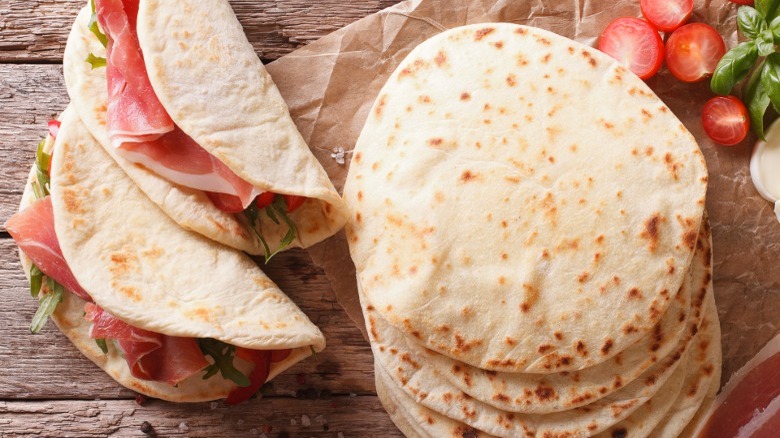The Underrated Italian Flatbread That Is Deliciously Simple To Make
Humans have been making and eating flatbreads for thousands of years. Many Middle Eastern and Mediterranean cultures have their own take on them, with famous examples including pita, manakeesh, lavash, and naan. In northern Italy's Emilia-Romagna region, the piadina is the flatbread of choice. All along this section of the Adriatic coast, you can find piadina stands offering up hot servings to tourists and locals alike. Though different cities have their preferences for thickness — a piadina may get thinner the further south you go — it's the kind of delicious street food that you won't soon forget.
Typically, piadine are thinner than other flatbreads like pita or naan, and they're used for making sandwiches as part of a light lunch, snack, or aperitivo (a pre-dinner drink and food combo). Most flatbreads can be the base for wraps or sandwiches, but some shine in being dipping breads, like Indian roti. However, the Italian piadina is less concerned with savory, saucy toppings or dips. Instead people usually just eat it with a blend of simple cold fillings, like prosciutto crudo (dry-aged and uncooked), tomato, creamy mozzarella, and arugula.
When a piadina makes the most sense
It's not hard to make piadina at home as it only uses water, flour, olive oil or lard, salt, and baking soda. The best part about piadina is that it doesn't require any yeast. Instead, it gets its leavening from a tiny bit of baking soda. Once you've mixed together the ingredients and kneaded it into a dough, you'll want to let the dough rest for a few minutes, which allows the gluten to relax prior to shaping.
Once you have the dough rested to perfection, all you have to do is roll it into balls, flatten them to your liking, and heat them up on a skillet, a process not so different from making a tortilla. Other flatbreads like focaccia taste delicious if you use a cast iron skillet to cook it, and the same applies to piadina. This bread should be served hot, as each bite should be warm, soft, and slightly savory.
Though this flatbread is not used for pizza traditionally, you could make a thicker version of piadina for a personal pizza, as some people enjoy doing with other fluffy flatbreads. Piadine are best for small sandwiches and wraps, but for something a bit unorthodox, you can also enjoy them solo or with a dip. Keep it simple and serve them with Trader Joe's garlic spread or a little olive oil and balsamic vinegar.

